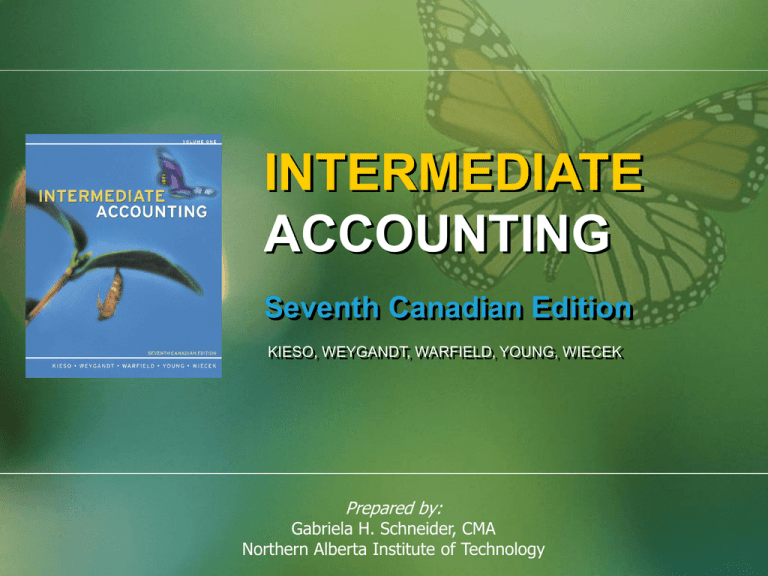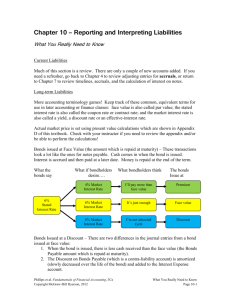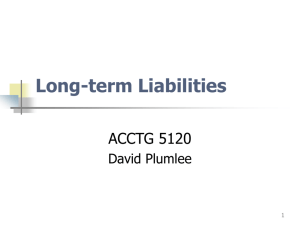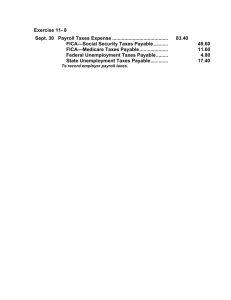
INTERMEDIATE
ACCOUNTING
Seventh Canadian Edition
KIESO, WEYGANDT, WARFIELD, YOUNG, WIECEK
Prepared by:
Gabriela H. Schneider, CMA
Northern Alberta Institute of Technology
CHAPTER
15
Long-Term Financial Liabilities
Learning Objectives
1. Describe the formal procedures associated with
issuing long-term debt.
2. Identify various types of long-term debt.
3. Explain the initial measurement of bonds/notes
at date of issuance.
4. Apply the methods of bond discount and
premium amortization.
Learning Objectives
5. Value bonds and consideration in special
situations.
6. Describe the accounting procedures for the
extinguishment of debt.
7. Explain the issues surrounding off-balance-sheet
financing arrangements.
8. Indicate how long-term debt is presented and
analysed.
Learning Objectives
9. Account for impairments on notes and loans
receivable. (Appendix 15A)
10. Distinguish between and account for debt
restructurings resulting in extinguishment
versus debt continuation. (Appendix 15A)
Long-Term Financial Liabilities
Nature of
Long-term
Debt
Measurement
and Valuation
Extinguishment/
Derecognition
Recognition
and
Presentation
Bonds
Notes
payable
Types of
bonds/notes
Bond ratings
Bonds/Notes
issued at par
Discounts and
premiums
Deep
discount/zero
interest
bonds/notes
Special
situations
Issuance costs
Repayment prior
to maturity date
Exchange of
debt instruments
Defeasance
Off-balancesheet
financing
Presentation
Long-term
debt
Note
disclosures
Appendix
15ATroubled
Debt
Impairment
of
Loans/Notes
receivable
Troubled
debt
restructuring
Perspectives
Issuing Long-Term Debt
• Obligations not payable within one year, or one
business operating cycle—whichever is longer
• Examples include:
–
–
–
–
–
Bonds payable
Long-term notes
Mortgages
Pension liabilities
Lease liabilities
• Often with restrictive covenants (terms) attached
Bonds
• Most common type of long-term debt
• A bond indenture is a promise (by the lender to
the borrower) to pay:
• a sum of money at the designated date, and
• periodic interest at a stipulated rate on the face
value
• A bond issue may be sold:
• either through an investment banker, or
• by private placement
Notes Payable
• Similar in nature to bonds
– Require repayment of principal at a future date
– Require periodic interest payments
• Difference is notes do not normally trade on
public markets
• Accounting for bonds and notes is the same
in many respects
Types of Long-Term Debt
• Bearer bonds: are freely transferable by current owner
• Secured and unsecured debt: secured by collateral (real
estate, stocks)
• Serial bonds: mature in instalments
• Callable bonds: give issuer right to call and retire debt prior
to maturity
• Income and Revenue bonds: interest payments tied to
some form of performance
• Deep-discount bonds: little or no interest payments; sold
at substantial discount
• Convertible bonds: can be converted into other corporate
securities for a specified time after issue
Bond Valuation:
Determining Bond Prices
• Price of a bond issue is determined by finding the
present value (PV) of future cash flows:
• the PV of the interest payment annuity (at the stated
or coupon rate of interest), plus
• the PV of the redemption (face, par) value,
• both discounted at the market (yield) rate of interest
in effect at issue date
• When market rate stated rate bond sells at
discount
• When market rate stated rate bond sells at
premium
Bond Valuation: Bond Price
Calculation
Given:
Face value of bond issue: $100,000
Term of issue: 5 years
Stated interest rate: 9% per year, payable end of
the year
Market rate of interest: 11%
Determine the issue price of the bonds.
Bond Valuation:
Bond Price Calculation
Year 1
$9,000
Year 2
$9,000
Year 3
$9,000
Interest
annuity
Year 4
$9,000
Year 5
$9,000
Face Value
$100,000
Discount the future cash flows
using the market (yield)
rate of interest
Bond Valuation:
Bond Price Calculation
Year 1
$9,000
$33,263
plus
$ 59,345
Year 2
Year 3
$9,000
$9,000
Year 4
$9,000
Year 5
$9,000
Discount at market rate, 11%
$9,000 x 3.69590
Discount at market rate, 11%
$100,000 x 0.59345
=$92,608 is the issue price
$100,000
Entries for the Issuance of Bonds
Sold at Par
Cash
1,000
Bonds Payable
1,000
Sold at a Premium
Cash
1,100
Premium on Bonds
100
Bonds Payable
1000
Sold at a Discount
Cash
Discount on Bonds
Bonds Payable
900
100
1000
Amortizing the Bond
Premium/Discount
• A premium effectively decreases the annual
interest expense for the corporation
• The discount effectively increases the
annual interest expense for the issuing
corporation
Amortizing the Bond
Premium/Discount
• Two methods available for amortization
– Straight line
• allocates the same amount of discount (or
premium) to each interest period
– Effective interest
• allocates the discount or premium in increasing
amounts over the bond term
Amortizing the Bond
Premium/Discount
• The total discount or premium amortized is
the same under both methods
• The straight-line method of amortizing is
acceptable under GAAP only if the results are
not materially different from those produced
by using the effective interest method
Straight-Line Method—Discount
Given:
Face Value = $800,000
Discount = $24,000
Coupon Rate = 10%
Bond Maturity = 10 years
The annual discount amortization =
$24,00010 years = $2,400
The entry to record the annual discount amortization would
be:
Interest Expense
2,400
Discount on Bonds
2,400
Straight-Line Method—Premium
Given:
Face Value = $800,000
Premium = $24,000
Coupon Rate = 10%
Bond Maturity = 10 years
The annual premium amortization =
$24,00010 years = $2,400
The entry to record the annual premium amortization would
be
Premium on Bonds
2,400
Interest Expense
2,400
Effective Interest Method
• Considers the change in interest costs as the
life of the bonds increases
• Uses the market rate at the date of sale to
calculate the amortization amount over the
life of the bond
Effective Interest Method
Calculation
Face Value = $100,000
Market Rate = 10%
Bond Maturity = 5 years
Year
1
2
3
4
5
6
7
8
9
10
A
B
Carrying
Value
Discount
Amortization
92,278
92,892
93,536
94,213
94,924
95,670
96,454
97,276
98,140
99,047
=C-D
-614
-645
-677
-711
-746
-784
-823
-864
-907
-952
Discount = $7,722
Coupon Rate = 8%
C
D
E
F
Interest
Interest Discount Carrying
Paid
Expense Balance
Value
Face Value
=A *
Face
* 4%
5%
Value - E
4,000
4,614
7,108
92,892
4,000
4,645
6,464
93,536
4,000
4,677
5,787
94,213
4,000
4,711
5,076
94,924
4,000
4,746
4,330
95,670
4,000
4,784
3,546
96,454
4,000
4,823
2,724
97,276
4,000
4,864
1,860
98,140
4,000
4,907
953
99,047
4,000
4,952
0 100,000
Effective Interest Method
The journal entry to record the bond issuance
is:
Cash
92,278
Discount on Bonds Payable 7,722
Bonds Payable
100,000
Effective Interest Method
The journal entry for first semi-annual payment
is:
Bond Interest Expense
4,614
Discount on Bonds Payable
614
Cash
4,000
Effective Interest Method
Calculation
Face Value = $100,000
Market Rate = 6%
Bond Maturity = 5 years
Year
1
2
3
4
5
6
7
8
9
10
A
B
Carrying
Value
Premium
Amortization
108,530
107,786
107,019
106,230
105,417
104,579
103,717
102,828
101,913
100,971
=C-D
744
766
789
813
837
863
888
915
943
971
Discount = $8,530
Coupon Rate = 8%
C
D
E
F
Interest
Interest Premium Carrying
Paid
Expense Balance
Value
Face Value
=A *
Face
* 4%
3%
Value - E
4,000
3,256
7,786 107,786
4,000
3,234
7,019 107,019
4,000
3,211
6,230 106,230
4,000
3,187
5,417 105,417
4,000
3,163
4,579 104,579
4,000
3,137
3,717 103,717
4,000
3,112
2,828 102,828
4,000
3,085
1,913 101,913
4,000
3,057
971 100,971
4,000
3,029
0 100,000
Effective Interest Method
The journal entry to record the bond issuance
is:
Cash
108,530
Premium on Bonds Payable
8,530
Bonds Payable
100,000
Effective Interest Method
The journal entry for first semi-annual payment
is:
Bond Interest Expense
Premium on Bonds Payable
Cash
3,256
744
4,000
Balance Sheet Presentation
Discount on bonds payable is a contra account:
Bonds Payable (face value):
$ XXX
Less: Unamortized Discount :
($ XX)
Bonds Payable (carrying value):
$ XXX
Premium on bonds payable is an adjunct account:
Bonds Payable (face value) :
$ XXX
Add: Unamortized Premium :
$ XX
Bonds Payable (carrying value):
$ XXX
Bonds Issued Between Interest
Dates
• Interest, for the period between the issue date
and the last interest date, is collected with the
issue price of the bonds
• At the specified interest date, interest is paid for
the entire interest period (semi-annual or annual)
• Premium or discount is also amortized from the
date of sale of bonds to the end of the interest
period
Deep Discount/Zero-InterestBearing Bonds/Notes
• If issued for cash PV = cash received by
issuer
• Interest rate is the rate that causes the PV (of
future cash flows) to equal cash received
• Difference between face amount and PV is
the discount
– Amortized over life of the note
Deep Discount/Zero-InterestBearing Bonds/Notes
Example: Jeremiah Company
• 10,000 3-year zero-interest-bearing note
issued
• Cash received at issuance: $7721.80
• Discount equal to:
$10,000
Less: Cash
7,722
$ 2,278
• Implied interest rate therefore: 9%
Note Issued for Cash
and Other Rights
• Sometimes, an issuer (borrower) of a note
payable with below-market interest gives the
recipient of the note (lender) additional
buying rights
• Then, the borrower is also the seller and the
lender is also the buyer
• The borrower must record both:
• a discount on the note, and
• unearned revenue
Example
Note Issued for Cash
and Other Rights
Given:
•
•
•
•
•
Issuer gives a 5 year, $100,000 note payable to
recipient on January 1st
The note is zero-interest bearing
The market rate is 10%
Recipient company has special rights to buy
$500,000 of merchandise from issuer company at
below market prices
Journalize in issuer’s books
Note Issued for Cash
and Other Rights
Books of the Issuer:
Cash
100,000
Discount on Note Payable
37,908
Note Payable
100,000
Unearned Revenue
37,908
PV of 100,000 at 10%, (n=5) = 62,902
Discount: (100,000 – 62,902) = 37,908
The discount is amortized over the term of note
The (unearned) revenue is recognized as sales are made
Note Issued for Cash
and Other Rights
Assume that the recipient purchased $50,000
worth of merchandise from the issuer.
The journal entry to record that revenue:
Cash (or A/R: Recipient) 46,209
Unearned Revenue
3,791
Sales Revenue
50,000
(Revenue recognized = $ 37,908 x ( $50,000/$500,000)
= $3,791
Notes Issued for Property,
Goods, and Services
•
•
Notes issued and payment is asset other
than cash
PV of debt at fair value of the property,
goods or services if:
1. No stated interest rate
2. Stated interest rate is unreasonable
3. Material difference exists between the stated
value of note and market value of the asset
being exchanged
•
Any discount or premium amortized over life
of the note
Bond Issue Costs
• Those costs incurred to physically issue the
bonds
– e.g., costs paid to the broker, legal costs
• Not part of any premium or discount
• Debited to a deferred charge
• Amortized over the life of the bond, using
straight line method
Extinguishment of Debt
• When debt is paid out prior to maturity
– Reacquisition, requires gain or loss to be
recorded
• May be for full amount of debt, or a portion
• At the time of reacquisition all outstanding
premiums, discounts, and issue costs are
amortized to the date of reacquisition
• Any gain or loss from the reacquisition is
reported with other capital gains/losses (does
not qualify as an extraordinary item)
Extinguishment of Debt
• Generally, when bonds are reacquired they
are cancelled
• If they are not cancelled, they are considered
treasury bonds
– May be resold or subsequently cancelled
• Treasury bonds are reported as a deduction
from Bonds Payable on the balance sheet
• Refunding of bonds: when a bond issue is
called in and replaced with a new issue (at a
lower rate of interest)
Extinguishment of Debt:
Example
Given:
• Existing debt:
• Called and canceled at:
• Unamortized discount:
• Unamortized bond issue costs:
$800,000
$808,000
$ 14,400
$ 9,600
Note: Both discount and bond issue costs have
been amortized up to the date of cancellation of
debt.
Give the journal entry for the extinguishment.
Extinguishment of Debt:
Example
Bonds Payable
800,000
Loss on Redemption
of Bonds
32,000
Discount on Bonds
14,400
Unamortized Bond Issue Costs
9,600
Cash
808,000
Defeasance
• Sufficient funds set aside (i.e. trust) to pay off
principal and interest on the debt
• “Legal defeasance” occurs when the debt
holder no longer has claim on the assets of
the original issuer
– Trust held responsible for repayment
• “In-substance defeasance” occurs when the
debt holder is not aware of the trust
arrangement
– CICA Handbook, Section 3855 (proposed) will
deal with whether or not this is deemed an
extinguishment of debt
Off-Balance-Sheet Financing
• Off-balance-sheet financing represents
borrowing arrangements that are not recorded
• The amount of debt reported in the balance
sheet does not include such financing
arrangements
• The objective is to improve certain financial
ratios (such as debt-equity ratio)
• In project financing arrangements, companies
form a new entity and borrow through that entity
• The debt appears on the books of the new entity,
and not on those of the parent companies
Off-Balance-Sheet Financing
• Different forms of off-balance-sheet financing
1. Non-consolidated subsidiaries
2. Special Purpose Entities (SPE)
or Variable Interest Entities (VIE)
3. Operating Leases
Presentation of Long-Term Debt
• Current versus long-term
– Debt to be refinanced treated as long-term
• Debt versus equity
– Dependent on nature of the instrument
• Classification of Discount and Premium
– Discount – contra account
– Premium – adjunct account
– Both reported within liability
Note Disclosure
• Include:
–
–
–
–
–
–
–
Nature of the liability
Maturity date
Interest rate
Call provision
Conversion privileges
Any restrictions imposed
Assets designated or pledged as security
Long-Term Debt Analysis
Debt to Total Assets:
Total debt
Total assets
• Level or percentage of assets that is financed
through debt
Times Interest Earned:
Income before income taxes and interest
Interest Expense
• Measures ability to meet interest payments
COPYRIGHT
Copyright © 2005 John Wiley & Sons Canada, Ltd.
All rights reserved. Reproduction or translation of
this work beyond that permitted by Access Copyright
(The Canadian Copyright Licensing Agency) is
unlawful. Requests for further information should be
addressed to the Permissions Department, John
Wiley & Sons Canada, Ltd. The purchaser may make
back-up copies for his or her own use only and not
for distribution or resale. The author and the
publisher assume no responsibility for errors,
omissions, or damages caused by the use of these
programs or from the use of the information
contained herein.






